Vermont Casting Winter warm User Manual

WinterWarm |
Fireplace Insert |
or System |
Homeowner’s |
Installation and |
Operating Manual |
For Use in North America |
SAFETY NOTICE: IF THIS APPLIANCE IS NOT PROPERLY INSTALLED, OPERATED AND MAINTAINED, A HOUSE FIRE MAY RESULT.
TO REDUCE THE RISK OF FIRE, FOLLOW THE INSTALLATION INSTRUCTIONS. FAILURE TO FOLLOW INSTRUCTIONS MAY RESULT IN PROPERTY DAMAGE, BODILY INJURY OR EVEN DEATH. CONTACT LOCAL BUILDING OFFICIALS ABOUT RESTRICTIONS AND INSTALLATION INSPECTION REQUIREMENTS IN YOUR AREA.
Do Not Discard This Manual: Retain for Future Use
2000941 3/07 Rev. 17
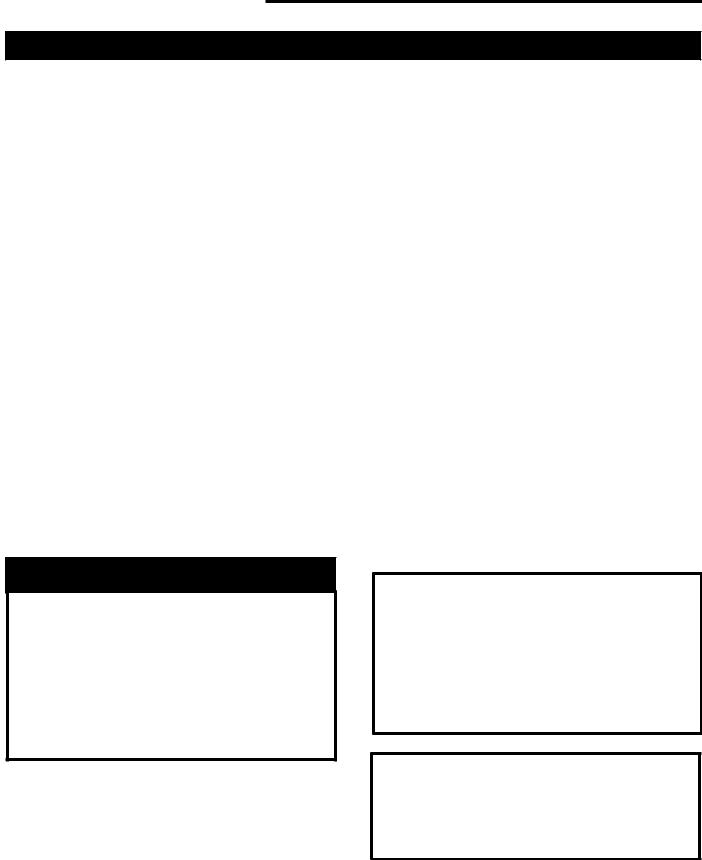
WinterWarm Fireplace Insert or System
Introduction
Thank you for purchasing a Vermont Castings’ WinterWarm, an efficient fireplace carefully engineered to bring you the latest in wood combustion principles and modern foundry technology.
The WinterWarm masonry Fireplace Insert turns a traditional masonry fireplace into a powerful heater; the WinterWarm Fireplace System combines an insulated metal cabinet with the Fireplace Insert so that it may be installed in close-clearance situations where no masonry fireplace and chimney exists.
Whichever you have purchased, you can count on years of comfortable heating and pleasureable fire viewing if you treat it properly and operate it according to the directions in this owner’s guide.
The WinterWarm Fireplace Insert, and the WinterWarm Fireplace System that utilizes the WinterWarm Fireplace Insert, are listed by Underwriter’s Laboratories of Canada, and are in compliance with the standards set forth by the Federal Environmental Protection Agency, 40 CFR Part 60.532(b), as stated on the permanent label attached to each appliance.
This manual describes the installation and operation of the WinterWarm catalytic-equipped wood heater. This heater meets the U.S. Environmental Protection Agency’s emission limits for wood heaters sold after July 1, 1990. Under specific test conditions this heater has been shown to deliver heat at a rate ranging from 10,300 to 30,000 Btu’s/hr.
For more complete details on WinterWarm performance and specifications, please refer to page 3.
The WinterWarm is designed, tested and listed for burning wood. Do not burn other fuels.
We recommend that you hire a professional installer certified by Wood Energy Technical Training (WETT) to install your WinterWarm, or to advise you on the installation should you attempt to install it yourself.
Please read the appropriate sections of this manual before you install and use your WinterWarm. For information on the installation of a WinterWarm into a masonry fireplace, read Sections III and V. To learn how to install the WinterWarm and its Cabinet that make up the fireplace system, read Sections IV and V. For information on Operation and Maintenance of the WinterWarm, read Sections I and II.
Failure to follow instructions may result in property damage, bodily injury or even death.
Save These Instructions For Future Reference
Table of Contents |
|
Introduction.................................................... |
2 |
Specifications ................................................ |
3 |
Operation....................................................... |
4 |
Maintenance.................................................. |
9 |
Preparing a Masonry Chimney.................... |
16 |
Installing the Fireplace System Cabinet ...... |
21 |
Appendices.................................................. |
38 |
Before you begin, here’s a timesaving tip on using this manual.
•To learn how to operate and maintain the WinterWarm, read Sections I and II.
•To install a WinterWarm Fireplace Insert into a masonry fireplace, read Sections III and V.
•To install a WinterWarm Fireplace System, read Sections IV and V.
Proposition 65 Warning: Fuels used in gas, woodburning or oil fired appliances, and the products of combustion of such fuels, contain chemicals known to the State of California to cause cancer, birth defects and other reproductive harm.
California Health & Safety Code Sec. 25249.6
2 |
2000941 |
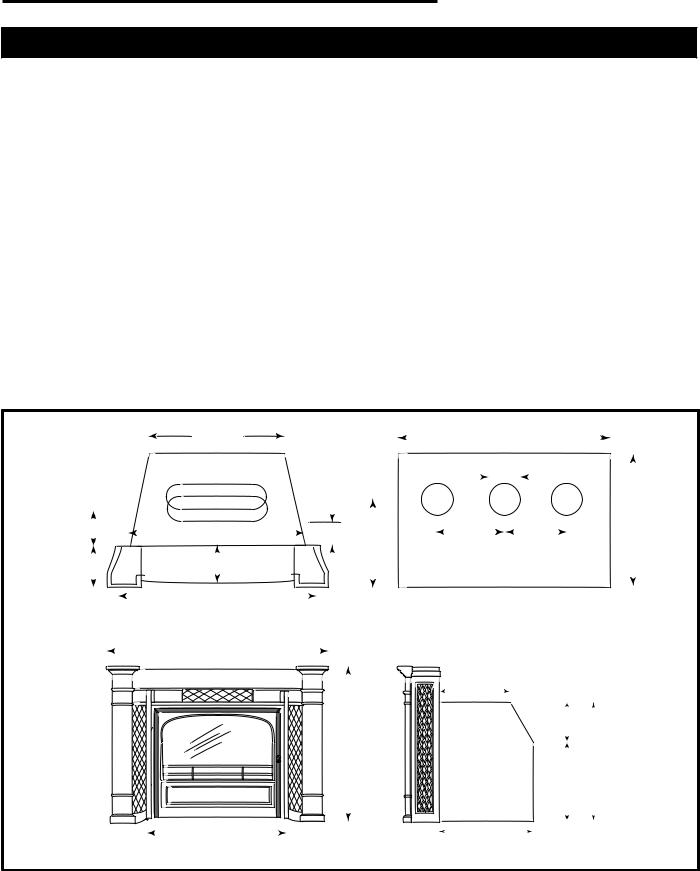
WinterWarm Fireplace Insert or System
Specifications
WinterWarm
Range of heat output* ............. |
10,300 - 30,000 BTU/hr |
Maximum heat output**.......................... |
50,000 BTU/hr |
Area heated***................ |
Up to 1500 sq. ft. (140sq. m) |
Size of wood splits....................... |
20-24” (508-610 mm) |
Fuel Capacity .......................................... |
40lbs. (18 kg) |
Loading.................................................................. |
Front |
Flue size.................................................... |
8” (203 mm) |
Fireplace Insert weight ........................ |
475lbs. (216 kg) |
Fireplace System weight ..................... |
840lbs. (380 kg) |
Primary Air Control ........................ |
Manual/thermostatic |
Secondary Air Control ............................ |
Self-regulating |
Glass panel ......................... |
High-temperature ceramic |
Flue exit position ..................................................... |
Top |
Blower rating ............................... |
106cfm. (115V, 60Hz) |
*Under specific test conditions used during EPA emissions standard testing.
**This value can vary depending on how the unit is operated, and the type and moisture content of the fuel used. Figure shown is based on maximum fuel consumption obtained under laboratory conditions and on average efficiencies.
***These values are based on operation in buildingcode conforming homes under typical winter climate conditions in New England. If your home is of nonstandard construction (e.g. unusually well insulated, not insulated, built under ground, etc.) or if you live in a more severe or more temperate climate, these figures may not apply. Since so many variables affect performance, consult your Vermont Castings’ Authorized Dealer to determine realistic expectations for your home.
|
21 " |
|
37 " |
||
|
(553 mm) |
|
(959 mm) |
||
|
4 " |
|
|
8" (203 mm) |
|
|
(121 mm) |
|
26 " |
||
|
|
|
|
||
6 " |
|
|
|
(676 mm |
|
|
|
12 " |
12 " |
||
(172 mm) |
33” (838 mm) |
15 " |
|||
(327 mm) |
(327 mm) |
||||
|
|
(394 mm) |
|||
7 " |
|
|
|
||
7 " (191 mm) |
|
|
|
||
(200 mm) |
|
|
|
||
|
|
|
|
||
|
36" |
|
Top View / System Cabinet |
||
|
(914 mm) |
|
|||
|
41" |
|
|
|
|
|
(1041 mm) |
|
|
|
|
|
|
|
13 " |
|
|
|
|
|
(349 mm) |
|
|
|
29 " |
|
7 " |
||
|
|
(200 mm) |
|||
|
(759 mm) |
|
|||
|
|
|
|||
|
|
|
|
23 " |
|
|
|
|
|
(603 mm) |
|
|
|
|
|
15 " |
|
|
|
|
|
(403 mm) |
|
|
25 " |
|
18 " (470 mm) |
||
|
(648 mm) |
|
|
|
|
Fig. 1 WinterWarm dimensions.
2000941 |
3 |
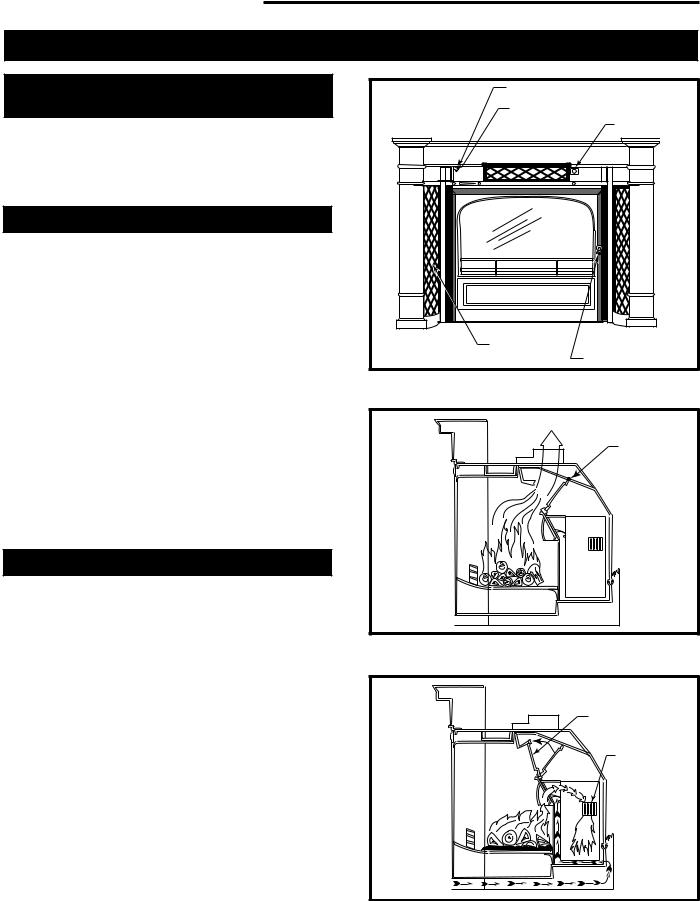
WinterWarm Fireplace Insert or System
Section I Operation
Your WinterWarm’s Controls
and What They Do
Three controls regulate the performance of your WinterWarm: A primary air control supplies oxygen for the fire, a damper directs air flow within the fireplace, and a variable-speed fan control, or rheostat, regulates the warm air flow into the room. (Fig. 2)
Primary Air Control
A single air control regulates the amount of heat the fire will produce and how long it will burn.
The primary air control is located above the upper left corner of the door. It is the top-most of the two brasscapped controls located there (the brass knob on the bottom regulates the fan), and is the primary source of air for starting, maintaining, and reviving the fire.
Generally, more air entering the stove makes the fire burn hotter and faster, while less air prolongs the burn.
The WinterWarm’s air supply is open to the maximum when the control lever is moved to the left, and closed when moved to the far right. It may be set anywhere between the two extremes, however, depending on the amount of heat desired.
To complement the manual setting of the air control, the WinterWarm has an internal automatic thermostat that ensures an even delivery of heat at the manual setting you select.
The Damper
The damper directs air flow within the fireplace.
The damper is operated by moving the lever located above the upper right corner of the door. It has two positions: Open, to start or revive the fire (Fig. 3); and closed (Fig. 4), for normal operation. The damper is open when the lever is to the far left, and closed when to the far right. There are no intermediate settings for damper position.
When the damper is closed, the front door automatically locks to prevent the door being inadvertently opened when the fireplace is in its catalytic mode. This could cause smoke to spill into the room.
To open the damper, lift up on the lever and move it to the far left. The lock will disengage, allowing you to open the front door.
To close the damper, move the lever to the right, continuing past the resistance to lock the damper in position. (The door handle must be positioned vertically before the lock mechanism will engage.)
|
Primary Air Control (Top Lever) |
||
|
Fan Speed Control |
|
|
|
(Rheostat) (Bottom |
Damper Control |
|
|
Lever) |
|
|
|
Optional Outside |
|
|
FP1070 |
Air Control |
Door Handle |
|
|
|||
Fig. 2 All WinterWarm controls are located conveniently on the front.
Damper
Open
FP1071
Fig. 3 The damper is open; Smoke is vented directly to the chimney.
Damper Closed
Catalytic
Combustor
FP1072
Fig. 4 Damper is closed: Smoke is channelled through the catalytic combustor where much of it can be burned.
4 |
2000941 |

The Fans
Two fans deliver a steady stream of warm air.
Heated air from your WinterWarm is forced into the room by two internal fans. The control for the fans is below the brass primary air control knob, just above the upper left corner of the door. (Fig. 5)
“Off” is to the far left.
“High” is just to the right of “Off.” “Low” is to the far right.
Variable adjustment of the fans is possible with any setting between “high” and “low.”
For best results, coordinate fan speed with the setting of your thermostat. For example, when the thermostat lever is set at “low,” also set the fans at “low.” With the thermostat set for maximum heat, set the fans at “high.”
Medium
Air Control Lever, Low Air Setting
High Air Setting 
Fan Control |
|
Lever (Fan Off) |
Fan On |
FP1073
Fig. 5 Variable settings for both the fans and the air control are possible between the two extreme settings.
Burn Only High-Quality Wood
The WinterWarm is designed to burn natural wood only; do not burn fuels other than that for which it was designed.
You’ll enjoy the best results when burning wood that has been adequately air-dried. Avoid burning “green” wood that has not been properly seasoned.
The best hardwood fuels include oak, maple, beech, ash, and hickory that has been split, stacked, and airdried outside under cover for at least one year.
For areas that do not have a supply of hardwood, commonly burned softwoods include tamarack, yellow pine, white pine, Eastern red cedar, fir, and redwood. These too should be properly dried. Your WinterWarm will accept wood up to 24” (610mm). Longer wood pieces work better than short ones.
WinterWarm Fireplace Insert or System
Wood should be stored under cover to maintain dryness, and should be dried at least six months for optimum heating and fire-viewing performance. Even for short-term storage, however, keep wood a safe distance from the heater and keep it out of the areas around the heater used for refueling and ash removal.
Use the Air Control Settings
that Work Best for You
No single air control setting will fit every situation. Each installation will differ depending on the quality of the fuel, the amount of heat desired, and how long you wish the fire to burn.
The control setting also depends on your particular installation’s “draft,” or the force that moves air from the stove up through the chimney. Draft is affected by such things as the length, type, and location of the chimney, local geography, nearby obstructions, and other factors.
Too much draft may cause excessive temperatures in the WinterWarm, and could even damage the combustor. On the other hand, too little draft can cause backpuffing into the room and/or the “plugging” of the chimney or combustor.
How do you know if your draft is excessively high or low? Symptoms of too much draft include an uncontrollable burn or a glowing-red part of the WinterWarm front. A sign of inadequate draft is smoke leaking into the room through the stove or chimney connector joints, low heat, and dirty glass.
In some newer homes that are well-insulated and weather-tight, poor draft may result from insufficient air in the house. In such instances, an open window near the stove on the windward side of the house will provide the fresh air needed.
Another option for getting more combustion air to the stove is to duct air directly from the outside to the stove. In fact, in some areas provisions for outside combustion air are required in all new construction.
Your WinterWarm is designed so that it is possible to incorporate outside air for combustion. Directions for installing the optional outside air duct may be found beginning with Step 4 on Page 31.
When first using the stove, keep track of the settings of the air controls. You will quickly find that a specific setting will give you a fixed amount of heat. It may take a week or two to determine the amount of heat and the length of burn you should expect from various settings.
Most installations do not require a large amount of combustion air, especially if adequate draft is available.
Do not for any reason attempt to increase the firing of your heater by altering the air control adjustment range outlined in these directions.
2000941 |
5 |

WinterWarm Fireplace Insert or System
Use the following air control settings as a starting point to help determine the best settings for your installation. Each is described as a fraction of the total distance the lever may be moved from right to left.
WinterWarm Control Settings
Burn Rate |
Primary Air Control |
Low |
From far right to 1/3 |
|
the distance to left |
Medium |
From 1/3 to 2/3 the distance |
|
to left |
High |
From 2/3 the distance |
|
to left to far left |
How To Build a Wood Fire and
Keep It Going
A WinterWarm leaves the factory with the combustor installed.
In the United States, it is against the law to operate this wood heater in a manner inconsistent with operating instructions in this manual, or if the catalytic combustor is deactivated or removed.
High-Efficiency Wood Burning
with Catalytic Combustion
The components of the catalytic combustion system in your WinterWarm work together to produce optimum conditions for secondary combustion.
When the damper is closed, smoke is directed through the catalytic element, which causes ignition of smoke at temperatures of 500-600°F (260-315°C), half the temperature normally required for unaided secondary combustion.
The catalytic element is a ceramic “honeycomb” coated with the catalytic material. The element is located in the secondary combustion chamber, molded from a special high-temperature insulating refractory material. The design of the chamber provides the correct environment necessary for secondary combustion of the fuel (smoke).
Catalytic combustion is activated by closing the damper, thereby exposing the smoke to the combustor.
Closing the stove damper may also reduce the draft, so to avoid putting out the fire or deactivating the combustor, close the damper only when a fire is well-estab- lished. When starting a fire, wait until the fire is well established and there is an ember bed of at least 3-4” (76 - 102mm) before closing the damper.
Never kindle a fire with colored paper or paper that has colored ink or a glossy surface, and never burn treated wood, garbage, solvents, or trash. All of these may poison the catalyst and prevent it from operating properly. Never burn cardboard or loose paper except
for kindling purposes. Never burn coal; doing so can produce soot or large flakes of char or fly ash that can coat the combustor and cause smoke to spill into the room. Coal smoke also can poison the catalyst so that it won’t operate properly.
In general, the fire must be sufficiently well-established to ensure that catalytic activity is initiated. When first starting a fire, a mediumto highfiring rate must be maintained for at least twenty minutes. This ensures that the stove, catalyst, and fuel are all stabilized at the proper operating temperatures.
Even though it is possible for the fire to get quite hot within a few minutes after a fire is started, the combustor may stop working or the fire may go out if the fire is allowed to die down immediately as a result of the damper being closed. Once the combustor starts working, heat generated by burning the smoke will keep it working.
To determine whether the combustor is operating, observe the amount of smoke leaving the chimney when the damper is activated and when it is not. This procedure is described on Page 12.
Starting and Maintaining a Wood Fire
Burn solid wood fuel only in the WinterWarm, and burn it directly on the grate. Do not elevate the fuel. Do not burn coal or other fuels.
Cast iron is a superior material for solid fuel stoves but it must be treated with respect. It is extremely strong, but can be broken with a sharp blow from a hammer or from the thermal shock of rapid and extreme temperature changes.
The cast plates expand and contract with changes in temperature. Minimize thermal stress by allowing the plates to adjust gradually during an initial break-in fire by following Steps 1-3 below.
Always be certain that the damper is open when starting a fire or when refueling. This rule is easy to remember, as the WinterWarm’s integrated door/damper interlock design does not permit opening the door unless the damper is already open. To open the damper, lift up
on the lever and move it to the left. (Fig. 6)
WARNING: Operate your WinterWarm only with the door fully closed and either the glass panel or spark screen in place. If the door is left partially open, gas and flame may be drawn out of the fireplace opening, creating risks of both fire and smoke.
6 |
2000941 |
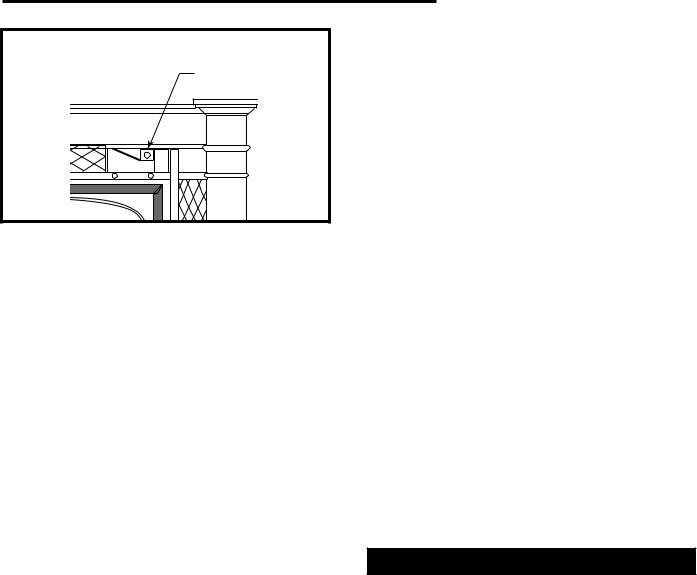
Open  Closed
Closed
Damper Control Lever
FP1074
Fig. 10 When the damper is closed, the front door automatically locks to prevent opening while a fire is burning.
1.Open the stove damper, and open the primary air control fully.
2.Lay some crumpled newspapers on the bottom grate. Place on the paper six or eight pieces of dry, finely-split kindling. On the kindling lay two or three larger sticks of split dry wood approximately 1-2” (25-51mm).
Do not use chemicals or fluids to start the fire. Do not burn garbage or flammable fluids such as gasoline, naptha, or engine oil.
Also, never use gasoline-type lantern fuel, kerosene, charcoal lighter fluid, or similar liquids to start or “freshen up” a fire in this heater. Keep all such liquids well away from the heater while it is in use.
3.Light the newspaper and close the door. Gradually build up the fire by adding a few 3-5” (76 - 127mm) diameter splits.
If this is your initial break-in fire, let the fire burn brightly, but not to excess. Control the fire’s intensity by adjusting the air control lever. After an hour or so stop adding wood so that the fire dies out gradually.
For ongoing operation after the initial break-in, continue to add a few sticks at a time of a progressively larger size. Be sure to keep the fuel load behind the front grate bar at all times. Continue until you have a live ember bed at least 3-4” (76 - 102mm) deep. This may take an hour or longer, particularly when the WinterWarm is vented to an exterior masonry chimney or when you are just starting a fire.
You’ll soon find out that the WinterWarm is HOT WHILE
IN OPERATION! KEEP CHILDREN, CLOTHING, AND FURNITURE AWAY. CONTACT MAY CAUSE SKIN BURNS.
WinterWarm Fireplace Insert or System
NOTE: Some chimneys need to be “primed,” or warmed up, before they will draw sufficiently to start a fire. To correct this situation, roll up a couple pieces of newspaper, place them on top of the kindling and toward the back of the stove, light them, and close the doors. This should heat the chimney enough to initiate a draft.
Once the draft is established, open the front door and light the rest of the fuel from the bottom. Do not light the main bed of fuel until the chimney begins drawing, and repeat the procedure as often as necessary if the initial attempt is unsuccessful.
4.Once a good ember bed of at least 3-4” (76 - 102mm) has formed, close the damper to activate the combustor. To ensure continued operation of the combustor, let the fire burn hot for an additional ten to fifteen minutes after the damper is closed.
5.Close the primary air control to a medium-low setting, or about 1/3 the distance from right to left in its travel range as described on Page 4. The fire volume will diminish immediately, but the WinterWarm will continue to heat up. Maintain control of the fire using the primary air control, and remember: reduce the setting for less heat, increase the setting for more heat. Refer back to the air control settings chart on Page 4 for recommended settings at different burn rates.
DO NOT OVERFIRE THIS HEATER. Overfiring may cause a house fire, or can result in permanent damage to the stove and to the catalytic combustor. If an exterior part of the WinterWarm glows, you are overfiring.
Reloading and Reviving a Wood Fire
Open the stove damper, set the air control on “High,” and wait at least fifteen seconds for the draft to increase. Open the door slowly.
Check the ash level, and empty the ash pan if necessary. Replace the pan.
Add the fuel, smaller pieces first. If it is necessary to use wood smaller than the 24” (610mm) optimum size, be sure to fill the firebox as completely as possible
by loading the wood pieces alternately on the left and right. Split wood will fill the firebox more completely and reduce the frequency of reloading.
If you have an ember bed of at least 3 - 4” (76 - 102mm), leave the damper open and the thermostat set on “high” for 10-15 minutes, then close the damper. If the ember bed is less than 3 - 4” (76 - 102mm), you may have to let it burn longer.
Finally, adjust the air control and fan speed for your desired heat level.
2000941 |
7 |
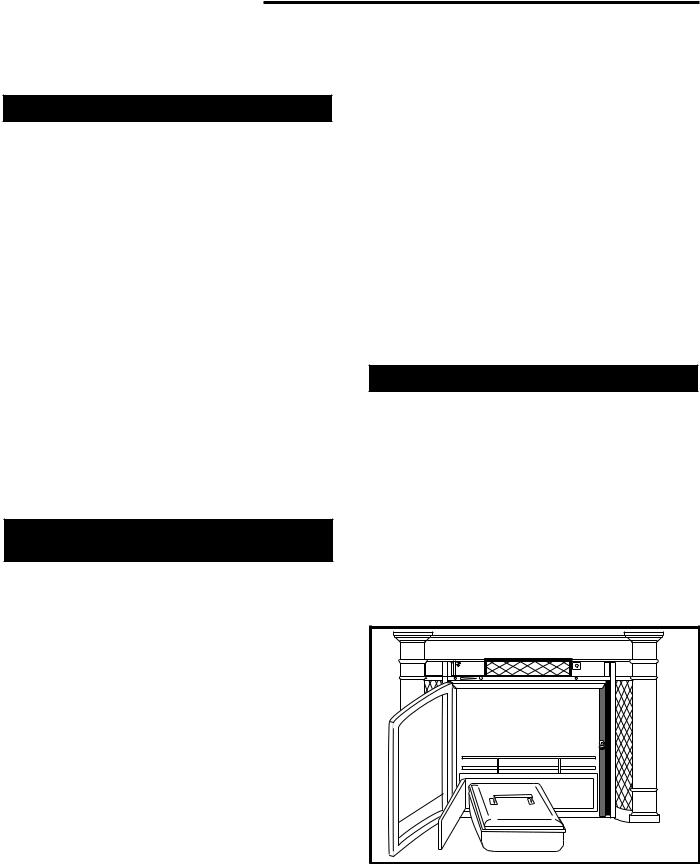
WinterWarm Fireplace Insert or System
NOTE: If the charcoal bed is relatively thick and your fuel is well-seasoned, it is possible to add fresh fuel (smaller pieces first), close the door and damper, and reset the air control within five minutes.
Special Tactics for Cold-Climate Heating
The WinterWarm is capable of producing up to 50,000 Btu’s/hour and heating an area of up to 1,500 ft.2 (140 m2) However, many factors affect heating performance and can influence the extent to which the WinterWarm can heat a given area.
A well-insulated home, located in a moderate climate and with the WinterWarm Fireplace Insert or Fireplace System located centrally in an open floor plan, will be easier to heat than a drafty home in the far north in which a WinterWarm is installed on an exterior wall at the end of a long house.
In Fireplace Insert installations, over-sized chimneys can produce less effective results than those that are properly sized, and interior chimneys usually perform better than those located outside the house.
Different results may be experienced even in the same installation if you switch from burning good, dry wood to wood that is partially rotted or inadequately seasoned.
To compensate for these factors in cold climates, it may be necessary to operate the WinterWarm for longer periods of time than described above before closing the damper, or to leave the air control set to a higher level more of the time.
Open-Fire Viewing with the Screen Cassette
The cassette screen that was included with your WinterWarm is interchangeable with the glass cassette, enabling you to convert from closed-door wood burning to protected open-fire viewing. Always leave the damper open when operating the WinterWarm with the screen in the open-fire mode.
To change cassettes, use this procedure:
Let the WinterWarm cool completely
•Open the door
•Loosen the two short retainer clips, one at each top corner of the cassette frame, and turn them to clear the frame.
•Tilt the top edge of the cassette away from the door frame.
•Carefully remove the cassette, being especially careful with the glass cassette. Store the unused cassette for future use.
8
•Examine the gasket that seals the cassette to the perimeter of the door frame. Contact your local dealer if you need a replacement gasket.
•Check the bottom channel of the door frame for debris, and clean if necessary.
•Insert the new cassette, bottom edge first, then the top edge.
IMPORTANT: The glass used in your WinterWarm is coated with a special material on one side that reflects heat back into the fire chamber. Before replacing a glass cassette that has been removed, examine the metal frame. One side has smooth, mitered corner joints; the other side has rough weld marks.
To install the glass correctly, the smooth mitered corners must be facing the gasket and the rough weld marks must be positioned toward the fire chamber.
•Replace the two retainer clips, applying just enough pressure to secure the cassette evenly against the gasket.
Remove and Store Ash Safely
Check the ash pan before reloading the stove, and empty if necessary using the following procedure:
•Open the damper
•Open the load door (Fig. 7)
•Pull open the ash chamber door with the hooked end of the fall-away handle.
•If the ash level is nearing the top, place the removable cover over the pan and make sure it is completely engaged. Ash may contain hot coals and must be treated with extreme care.
•Take the pan outdoors and empty the ash into your ash container.
|
FP1075 |
Fig. 7 |
Carefully remove ash pan. |
|
2000941 |

•Before replacing the ash pan, clear away any ash that has spilled over the sides and back of the pan.
•Replace the ash pan and close the ash door and front door.
Empty the ash pan regularly, typically every one to three days. The frequency will vary depending on how you operate your WinterWarm: You burn more wood at higher heat output settings, and ash will accumulate faster.
Ash should be removed frequently and placed outdoors in a metal container with a tight-fitting lid. The closed container of ash should be placed on a noncombustible floor or on the ground, well away from all combustible materials, pending final disposal. If the ash is disposed of by burial in soil or otherwise locally dispersed, it should be retained in the closed container until all cinders have thoroughly cooled. -Wood ash may be used as a garden fertilizer.
CAUTION: Never use your household or shop vacuum cleaner to remove ash from the fireplace; always remove and dispose of the ash properly.
WinterWarm Fireplace Insert or System
Section II Maintenance
Keep your WinterWarm Looking New and Working Its Best
Care of the Cast Iron Surface
An occasional dusting with a dry rag will keep the painted cast iron of your WinterWarm looking new.
If the paint needs retouching, first allow the surface to cool completely. Wire-brush areas needing to be painted. Touch-up with high temperature stove paint available from your local dealer. Apply the paint sparingly. Two light coats are better than one heavy one.
Care of the Porcelain Enamel Surface
Use a soft brush as necessary. Do not use water or other liquids on your WinterWarm. Fingerprints usually can be buffed off porcelain enamel with a dry, soft cloth. If marks remain, allow the WinterWarm to cool completely, then buff with a slightly damp, soft cloth. Dry completely before starting a fire to avoid streaking.
Never use abrasives or harsh chemical cleaners on the porcelain enamel finish. The enamel may scratch and expose the cast iron, which can then stain or rust. If you must remove spills or stains from porcelain surfaces, make sure that the fire is out and that the WinterWarm has cooled completely before cleaning. Use a kitchen appliance cleaner and polish especially formulated for enamel surfaces. Apply the cleaner sparingly with a soft cloth, and buff away all traces.
Cleaning the Glass
The WinterWarm glass system requires a minimum amount of cleaning. Most carbon deposits that accumulate will burn off during hot fires.
Ash residue that accumulates on the glass should be removed periodically to prevent etching. To clean the glass, follow this procedure:
•Be sure the glass is completely cool.
•Cleaning with water will work in most cases. Use a glass cleaner especially made for this purpose only if deposits are especially heavy. (If heavy deposits are a frequent occurrence, however, evaluate your operating techniques.)
•Rinse the glass thoroughly.
•Dry the glass completely.
NOTE: The WinterWarm glass is coated with a special material on one side that helps reflect heat back into the fire chamber. Do not attempt to remove this coating.
2000941 |
9 |
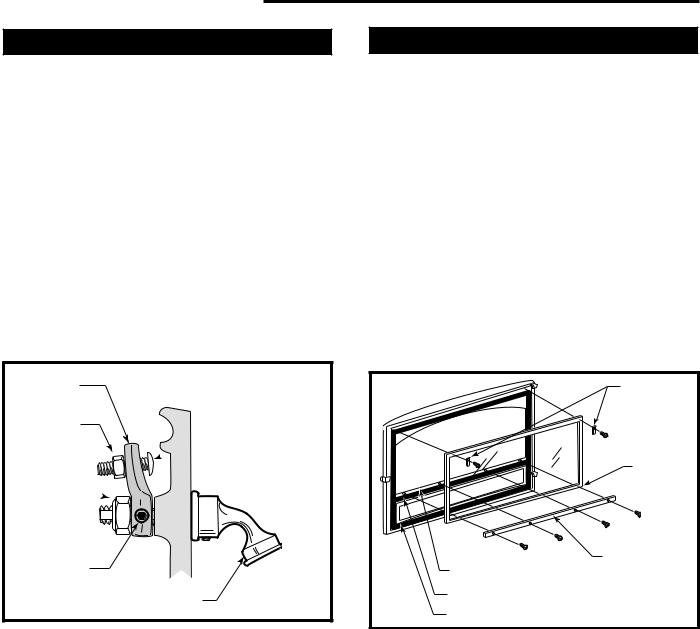
WinterWarm Fireplace Insert or System
Adjust the Door Latch Periodically
The front door of the WinterWarm should close securely to prevent accidental opening and should close tightly to prevent air from leaking into the fire chamber. The door handle will be positioned vertically when the door is closed.
Over a period of time, the gasket around the door will compress and the latch may need adjustment. To adjust the handle, follow this procedure (Fig. 8):
1.Loosen the small lock nut with a wrench.
2.Extend the striker screw one turn by turning it with an Allen wrench.
3.Re-tighten the lock nut, while at the same time holding the striker screw with the Allen wrench to prevent its turning.
Test the door seal. Close the door on a dollar bill and attempt to pull it free. If the bill is freed with little resistance, the gasket isn’t snug enough at that spot. Contin-
Pawl
Small
Locking Nut
 Striker Screw
Striker Screw
Large
Locking
Nut 
Set Screw
Handle Stub |
ST531 |
|
Fig. 8 An adjustable latch lets you restore a tight seal to the WinterWarm’s door.
ue to make small adjustments until the setting is right.
If additional adjusting of the latch does not enable the door to seal sufficiently in one area, try “adjusting” the gasket in that area. Pack more cement or a smaller diameter gasket into the channel beneath the gasket so the main gasket is raised and makes contact with the door frame. This procedure should solve the problem. If it doesn’t, replace the gasket following the directions below.
How to Replace Gaskets
Your WinterWarm uses rope-type fiberglass gaskets
to make a tight seal between some parts. With use, particularly on those parts that move, gaskets can become brittle and compressed and can begin to lose their effectiveness. These will need periodic replacement.
All of the gaskets used are made of fiberglass. The three sizes of replaceable gasket are listed below,
along with their application.
Replaceable WinterWarm Fiberglass Gaskets
Gasket Size... |
...And The Parts It Seals |
1/2” |
The door to the front (#1) |
1/2” |
The door to the front edge of |
|
the grate (#2) |
3/16” |
The cassette glass seal to |
|
the door (#3) |
3/8” The damper to the upper fireback (#4)
|
Short Re- |
|
tainer Clips |
|
Welded |
|
Corner |
|
Toward |
|
Firebox |
|
Long Retainer |
#3 Gasket |
Clips |
|
|
#2 Gasket |
|
#1 Gasket |
FP1076 |
Fig. 9 Front door components allow replacement of the glass, gaskets or both.
Should you need to change a replaceable gasket, wait until the fire is out and the stove has cooled. Be sure to follow the standard safety procedure for working with dusty materials: Wear safety goggles and a dust mask. The procedure for replacing gaskets is the same, regardless of the gasket location. Four easily-accom- plished steps are involved:
1.Remove the existing fiberglass gasket by grasping an end and pulling firmly.
2.Use a wire brush or the tip of a screwdriver to clean the channel of any remaining cement or bits of gasket.
3.Apply a thin bead of stove cement to the newlycleaned groove.
4.Pack a new gasket into the groove. Wait until you have placed all but a couple inches from the end before you trim the end to an exact fit.
10 |
2000941 |

Replacing the Door Gaskets
Remove the door by lifting it straight up off its hinge pins. Lay it face down on a padded surface.
Follow steps 1-4 as described above.
|
#3 Gasket |
|
#1 Gasket |
#2 Gasket |
FP1077 |
|
Fig. 10 Location of door gaskets.
Replacing the Damper Gasket
Remove the front grate, bottom grate, ash pan, and ash pan frame.
Follow steps 1-4 as described above.
|
#4 Gasket |
|
|
3/8” (10mm) Tail |
FP1078 |
|
|
|
Fig. 11 |
Location of damper gaskets. |
|
Other gaskets form seals between non-moving parts, but these are not subject to the same wear and deterioration as gaskets on moving parts. It is unlikely that you will ever need to replace these gaskets unless the involved parts are disassembled and then put back together. In any event, this is a job that should be done only by qualified service personnel.
WinterWarm Fireplace Insert or System
Permanent WinterWarm Gaskets
Gasket size... |
...And The Parts It Seals |
1/2” |
The underside of the top plate to |
|
the top edge of the air manifold |
5/16” |
The flue collar to the top plate |
5/16” |
The right end of the air |
|
manifold to the right side plate |
5/16” |
The left end of the firechamber to |
|
the left end of the air manifold |
5/16” |
The bottom edge of the lower |
|
firebackto the bottom plate |
5/16” and 3/8” |
The ends of the upper fireback to |
|
the lower fireback and to the ribs |
|
of the right and left side plates |
Replace Damaged Door Glass Immediately
Do not operate the WinterWarm with a damaged glass (or screen) cassette. Use the following procedure for cassette replacement.
NOTE: Replace glass only with CFM Corporation high temperature ceramic glass, available from your Vermont Castings’ Authorized Dealer.
•Open the door and loosen the two retaining clips, one at each upper corner, which hold the cassette to the door frame. Swing the clips out of the way. Tilt the cassette away from the door frame and lift up. Use caution when handling a cassette that contains broken glass.
•Examine the gasket that seals the cassette to the door frame. Replace if necessary with gasket obtained from your local Vermont Castings’ Authorized Dealer. See the directions for gasket replacement on page 9.
•Check the channel at the bottom of the door frame, and clear away debris if necessary.
IMPORTANT: The glass used in your WinterWarm is coated with a special material on one side that reflects heat back into the fire chamber. Before replacing a glass cassette that has been removed, examine the metal frame. One side has smooth, mitered corner joints; the other side has rough weld marks.
To install the glass correctly, the smooth mitered corners must be facing the gasket and the rough weld marks must be positioned toward the fire chamber.
• Secure the clips, being careful not to over-tighten. Be sure the cassette is firmly seated against the gasket. Close the door gently to confirm that the clips have been properly positioned. It is possible for the glass to be damaged if the clips have been installed incorrectly and the door is closed with force.
2000941 |
11 |
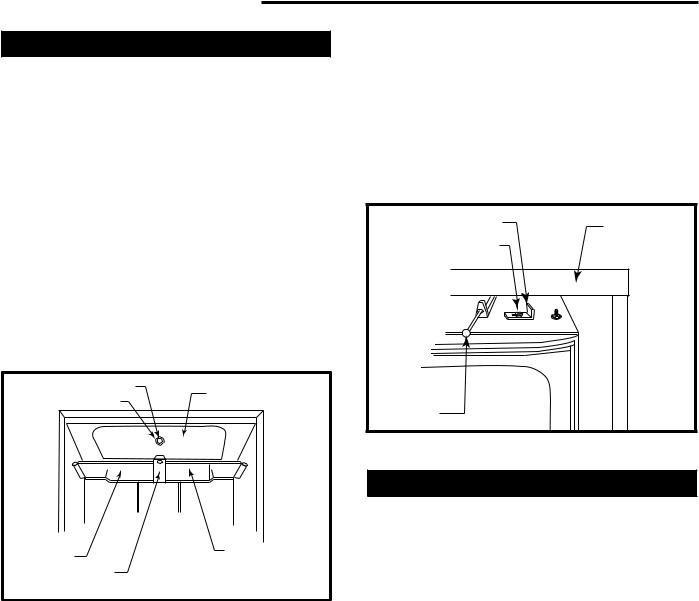
WinterWarm Fireplace Insert or System
Adjust the Damper as Needed
Examine your WinterWarm’s damper after the first 50 hours of use and adjust it if necessary. Thereafter, check the damper at least once a year and adjust as needed.
Both fine and coarse adjustments to the damper are possible. Begin with the fine adjustment, which modifies the pressure on the damper plate directly; it will take care of most sealing problems. Proceed to the coarse adjustment, which adjusts the pressure at the damper latch, only if you cannot achieve a satisfactory seal with the fine adjustment.
To inspect how well the damper seals, first make sure that the fire is out and that the WinterWarm is cool. Open the front door, and close and lock the damper. Visually inspect the seal between the damper plate and the damper frame; there should be no gaps. Now, push gently on the damper — there should be some give, but no rattle. If there is a gap in the seal or a rattle, adjust the damper.
Damper Adjustment Screw |
Damper |
|
Lock Nut |
||
|
Left
Throat Half Right Throat
Half
Throat Retainer Clip
FP1080
Fig. 12 A view of the damper as seen through the front door.
Try the Fine Adjustment First
1.Open the door.
2.Close and lock the damper.
3.Locate the damper adjustment set-screw in the center of the damper plate, and loosen its lock nut.
4.Turn the set-screw 1/4 to 1/2 turn clockwise.
5.Check the damper seal for gap or rattle.
6.When the set screw position provides a good seal, tighten the lock nut. Be careful not to overtighten the set screw.
Use the Coarse Adjustment Only If Necessary
Follow Steps 1-3 of the fine adjustment procedure, then;
1.Turn the set screw counter-clockwise several full turns.
2.Lift off the mantel piece to expose the damper latch.
3.With the damper open, loosen the latch retaining screw.
4.Move the latch approximately 1/8” (3mm) to the right, and retighten the retaining screw.
5.Close and lock the damper, and check for gap and rattle. Adjust the set screw as described under “Fine
Adjustment.”
Repeat the coarse adjustment if necessary.
For further assistnce, contact your Vermont Castings’ Dealer.
Damper Latch |
Shroud |
|
Latch Retaining Screw
Damper |
|
Control |
|
Rod |
FP1081 |
|
Fig. 13 With the mantel removed, the damper latch is exposed for adjustment.
Care of the Catalytic Combustor
This wood heater contains a catalytic combustor, which needs regular inspection and periodic replacement
for proper operation. It is against the law in the United States to operate this wood heater in a manner inconsistent with operating instructions in this manual, or if the catalytic element is deactivated or removed.
Under normal operating conditions, the catalytic combustor should remain active for two to six years (depending on the amount of wood burned). However, it is important to monitor the combustor periodically to ensure that it is functioning properly, as well as to determine when it needs to be replaced. A non-functioning combustor will result in a loss of heating efficiency, and an increase in creosote and emissions.
The combustor should be visually inspected “in place” for fly ash accumulation and physical damage three times per year. Actual removal of the combustor is not recommended unless a more detailed inspection is warranted because of diminished performance as outlined below.
The refractory package that houses the catalytic combustor should be inspected annually for a build-up of fly ash and cleaned if necessary. This may be done during examination of the catalytic combustor.
The catalytic combustion system includes an air supply for secondary combustion. The probe which controls the supply should also be inspected annually.
12 |
2000941 |
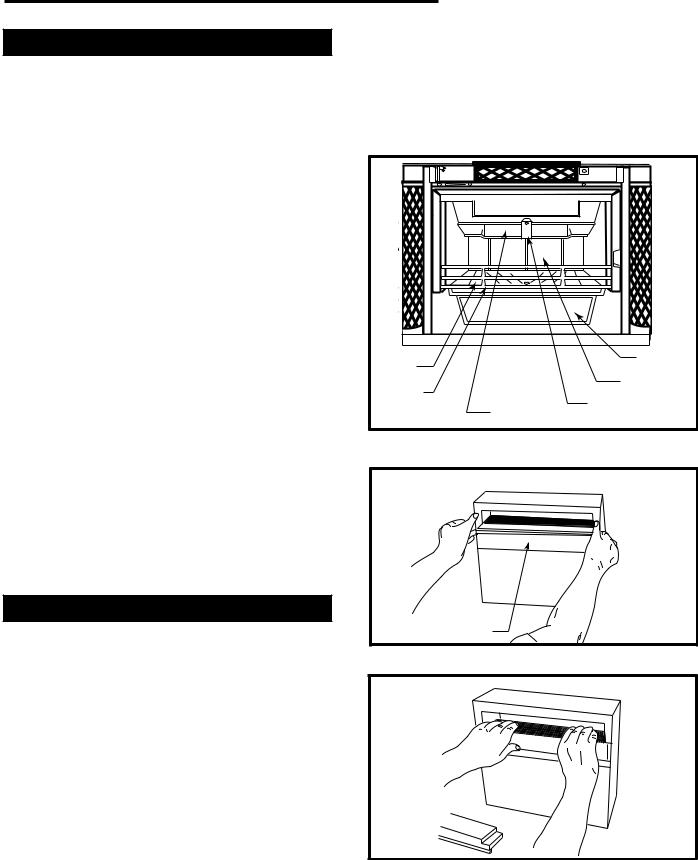
When to Suspect a Combustor Problem
The best way to evaluate the performance of your WinterWarm’s combustor is to observe the amount of smoke leaving the chimney — both when the combustor has achieved “light-off” and when it has not. Follow this simple two-step procedure:
•With a fire going and the combustor properly activated with the damper closed to route smoke through it as described in the Operation Section, go outside and observe the smoke leaving the chimney.
•Then, open the stove damper and once again observe the smoke leaving the chimney.
Significantly more smoke should be observed after the second step when the stove damper is open and
exhaust is not routed through the combustor. Be careful not to confuse smoke with steam from wet wood.
If this test indicates a problem, consider other possible factors as well, such as the time of year or a change in the quality of your fuel. In spring and fall, draft is weaker than it is in colder winter weather, and fires can burn sluggishly. Small, hot fires are a good solution under these conditions.
Burning “green” (insufficiently seasoned) wood will result in poorer performance than when burning properly seasoned fuel. You may have to run your stove hotter (more air) to achieve good performance if you are burning green or wet wood.
Also, consider any changes in your operating routine as well.
Once you have ruled out any other possible causes for a decline in performance, you may proceed with an inspection of the combustor.
Inspection and Removal of the Combustor
Before you begin, observe the basic safety precautions for working with dusty materials: always wear safety glasses, a recommended dust mask, and gloves. To expose the combustor, first remove the throat pieces by tapping upward at the far left and right corners with a soft-faced hammer. Leave the bolt in the retainer loose, and leave the retainer in place.
Examine the top surface of the catalytic element, which will be visible. A small mirror and flashlight may provide a better view. Unless the element shows a heavy fly ash accumulation or major damage, do not remove it.
If combustor removal is necessary for cleaning or closer inspection, follow these steps (Fig. 14):
1.Remove the front grate bar.
2.Remove the grate.
3.Remove the throat pieces as described above
WinterWarm Fireplace Insert or System
4.Tip the lower fireback forward, and remove it by lifting it up and toward you.
5.Carefully remove the access panel. (Fig. 15) It is extremely delicate and should be handled as little as possible.
6.Slide the catalytic element out. (Fig. 16) Handle it carefully, as the element is fragile.
Grate |
|
Ash Door |
|
|
|
Front |
|
Lower |
|
Fireback |
|
Grate Bar |
|
|
|
Retainer |
|
|
Throat Pieces |
|
|
FP1079 |
|
|
|
Fig. 14 To reach the catalytic combustor, remove front grate bar, grate, throat pieces and lower fireback.
Access Panel |
FP1082 |
Fig. 15 Remove the access panel.
FP1083
Fig. 16 Removing the catalytic element.
2000941 |
13 |
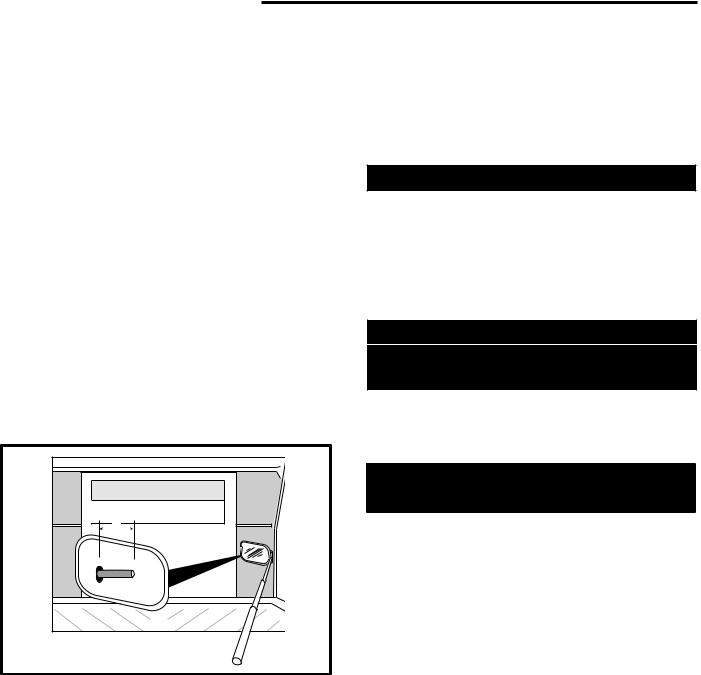
WinterWarm Fireplace Insert or System
•Check the combustor and the bottom of the refractory chamber for a build-up of fly ash, and remove any ash by taking the combustor outside and gently blowing air through the element. Do not brush the surface, as this could damage the element. Carefully vacuum ash from the refractory chamber.
•Refer to the “Catalytic Combustor Appendix” on Page 37 for information on what kinds of damage or deterioration to look for. Although small hairline cracks will not affect performance, the combustor should be essentially intact. If the combustor is broken in pieces or has sections missing, it should be replaced. Call your local Vermont Castings’ dealer for a replacement combustor, item #30001152. Consult the warranty section at the back of this manual for further information on catalytic combustor replacement.
•While the catalytic element is removed, check the condition of the secondary air probe. Use an inspection mirror to locate the probe within the combustion chamber. (Fig. 17) The probe should extend 1 to 1¹⁄" (25 - 38mm) into the chamber and show no signs of deterioration, (warping, short length). Refer to the next illustration. A damaged secondary air probe could affect catalytic performance. If the probe needs to be replaced, call your local dealer.
|
1" |
|
ST559 |
Fig. 17 |
Use an inspection mirror to check the secondary |
probe. |
|
If the combustor is in good condition and clean, re-in- stall it following this procedure:
1.Slide the element carefully back into the refractory chamber, seating it securely. The element must be fully to the rear of the support slot.
2.Install the access panel, making sure that it is flush with the outer surface of the main refractory package.
3.Check the slot in the rear bottom plate for debris, and clean if necessary.
4.Reinstall the lower fireback by inserting the base of the fireback in the slot. Tip the fireback up into place.
5.Reinstall the throat pieces, center edges first, then outer edges. Tap the throat pieces downward firmly to seat the lower fireback.
6.Replace the grate.
7.Replace the front grate bar. With the horizontal bars pointing down and away from you, angle the bar inside the firebox to seat the right end. Then, bring the left end forward and lower it into position.
Watch for Better Results
Finish up by cleaning the chimney and chimney connector. Then, use your WinterWarm in a typical manner for two weeks and observe its performance, taking particular note of the smoke observation test described on Page 11.
If a problem persists, contact your local dealer for further advice about your particular situation.
The Chimney System
A Clean Chimney System is
Safer and Works Better
Although the catalytic combustion system in your WinterWarm can reduce creosote formation dramatically, it is not a substitute for regular inspection and cleaning of the chimney and chimney connector.
Learn to Recognize — and Avoid — Creosote
Your WinterWarm has been designed to reduce creosote build-up significantly. However, regular chimney inspection and maintenance must still be performed.
For safety, good stove performance, and to protect your chimney and chimney connector, inspect your chimney and chimney connector on a regular schedule. Clean the system if necessary. Failure to keep the chimney and connector system clean can result in a serious chimney fire.
When wood is burned slowly, it produces tar, organic vapors and moisture which combine to form creosote. The creosote vapors condense in the relatively cool chimney flue of a slow-burning fire. As a result, creosote residue accumulates on the flue lining. When ignited, this creosote makes an extremely hot fire within the flue system that can damage the chimney and overheat adjacent combustible material. If a significant layer of creosote has accumulated —1/8” (3mm) or more — it should be removed to reduce the risk of a chimney fire.
If you do experience a chimney fire, act promptly to:
•Close the damper and thermostat lever.
•Get everyone out of the house.
•Call the Fire Department.
14 |
2000941 |
